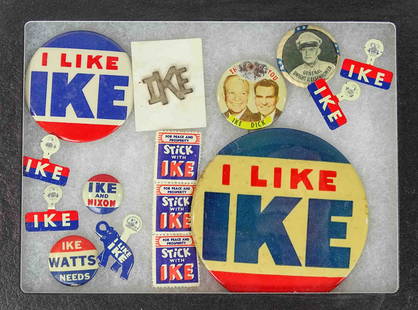
20th C. Polynesian Tongan Rubbing Stamp / Kupesi
Similar Sale History
Recommended Items





Item Details
Description
**Originally Listed At $800**
Oceania, Polynesia, Tonga, ca. 20th century CE. A rare example of a rubbing stamp known as a kupesi, used as a template for creating patterns on traditional tapa backcloth. The kupesi is constructed from a square of pandanus or coconut sheath, that is then laminated to a tapa cloth back, the stamp face has raised twigs (coconut midribs) wrapped in thin coconut fiber strands, the twigs are then sewn to the mat. The coiled coconut around the twigs adds texture and contrast when the ink is applied. To make patterns with a kupesi, this template is placed under the cloth, ink is applied on top of the tapa cloth and rubbed into the fibers. To just make the stencil must have been a painstaking process, not to mention the work that went into processing the tapa cloth that the back plate is covered in, and the tapa textile the stamp would have been used on! Size: 12" L x 11" W (30.5 cm x 27.9 cm)
According to the curatorial staff at Harvard University's Peabody Museum: "For hundreds of years, tapa making was one of the most sophisticated plant-fiber technologies in the Pacific Islands. In the eighteenth century and before, tapa served as both daily and ceremonial clothing. It was made into headdresses, turbans, loincloths, sashes, girdles, skirts, and ponchos. The cloth was used for bedcovers, wall dividers, or mosquito curtains as well as for special wrappings of staff gods, for the outer layer of sculptures, for wrapping skulls, and for masks. Individuals were surrounded by tapa at birth, weddings, and death. Special cloths were made for dowries, diplomatic gifts, and treaty agreements. Large-scale accumulation of tapa signified wealth and aided in achieving status. It was also used to pay tribute. Barkcloth material, partially processed or as undecorated sheets, was an important trade item and was exchanged for plaited mats, adzes, whale teeth, and sandalwood. Eventually, the increased availability of woven cotton cloth made in Asia and Europe led to a significant decline of hand-produced tapa, altered its use, and encouraged further changes in the ways in which tapa was decorated."
Provenance: private Newport Beach, California, USA collection
All items legal to buy/sell under U.S. Statute covering cultural patrimony Code 2600, CHAPTER 14, and are guaranteed to be as described or your money back.
A Certificate of Authenticity will accompany all winning bids.
We ship worldwide to most countries and handle all shipping in-house for your convenience.
#160980
Oceania, Polynesia, Tonga, ca. 20th century CE. A rare example of a rubbing stamp known as a kupesi, used as a template for creating patterns on traditional tapa backcloth. The kupesi is constructed from a square of pandanus or coconut sheath, that is then laminated to a tapa cloth back, the stamp face has raised twigs (coconut midribs) wrapped in thin coconut fiber strands, the twigs are then sewn to the mat. The coiled coconut around the twigs adds texture and contrast when the ink is applied. To make patterns with a kupesi, this template is placed under the cloth, ink is applied on top of the tapa cloth and rubbed into the fibers. To just make the stencil must have been a painstaking process, not to mention the work that went into processing the tapa cloth that the back plate is covered in, and the tapa textile the stamp would have been used on! Size: 12" L x 11" W (30.5 cm x 27.9 cm)
According to the curatorial staff at Harvard University's Peabody Museum: "For hundreds of years, tapa making was one of the most sophisticated plant-fiber technologies in the Pacific Islands. In the eighteenth century and before, tapa served as both daily and ceremonial clothing. It was made into headdresses, turbans, loincloths, sashes, girdles, skirts, and ponchos. The cloth was used for bedcovers, wall dividers, or mosquito curtains as well as for special wrappings of staff gods, for the outer layer of sculptures, for wrapping skulls, and for masks. Individuals were surrounded by tapa at birth, weddings, and death. Special cloths were made for dowries, diplomatic gifts, and treaty agreements. Large-scale accumulation of tapa signified wealth and aided in achieving status. It was also used to pay tribute. Barkcloth material, partially processed or as undecorated sheets, was an important trade item and was exchanged for plaited mats, adzes, whale teeth, and sandalwood. Eventually, the increased availability of woven cotton cloth made in Asia and Europe led to a significant decline of hand-produced tapa, altered its use, and encouraged further changes in the ways in which tapa was decorated."
Provenance: private Newport Beach, California, USA collection
All items legal to buy/sell under U.S. Statute covering cultural patrimony Code 2600, CHAPTER 14, and are guaranteed to be as described or your money back.
A Certificate of Authenticity will accompany all winning bids.
We ship worldwide to most countries and handle all shipping in-house for your convenience.
#160980
Condition
Some fraying and loosening to coiled coconut fiber strands. Overall great condition and a rare tool.
Buyer's Premium
- 26.5%
20th C. Polynesian Tongan Rubbing Stamp / Kupesi
Estimate $1,200 - $1,800
5 bidders are watching this item.
Shipping & Pickup Options
Item located in Louisville, CO, usOffers In-House Shipping
Local Pickup Available
Payment
Accepts seamless payments through LiveAuctioneers

Related Searches
TOP





















































